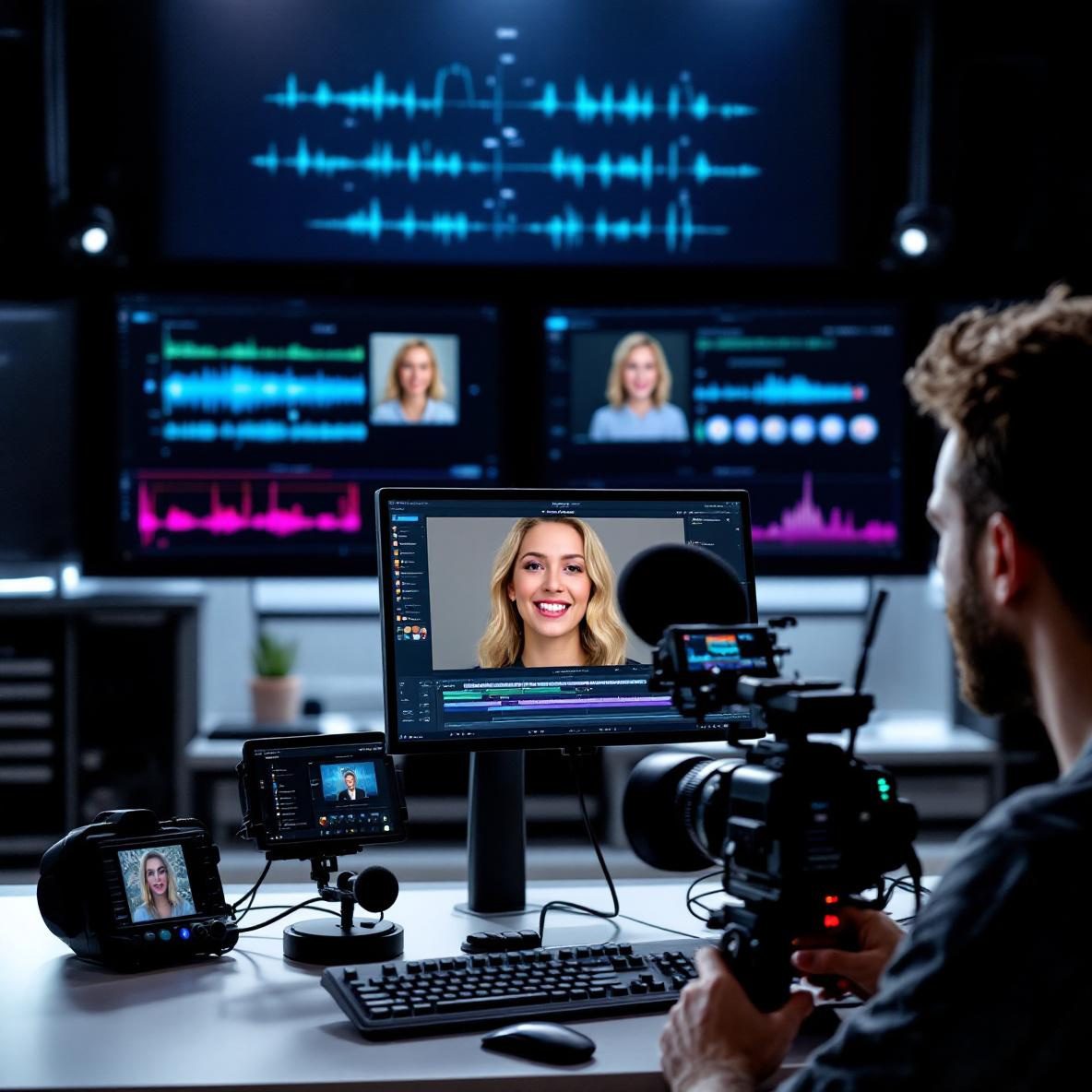What is HeyGen and How It Actually Works
HeyGen is one of those tools that feels like magic the first time you use it. You upload some text or record a voice, pick a face (or create your own), and boom — within a few minutes, you’ve got a video that looks like someone is clearly speaking those words. Their lips move, their voice is cloned, and it feels weirdly human-like. But how well it works depends a lot on what you’re doing with it.
Thank you for reading this post, don't forget to subscribe!At its core, HeyGen is an AI video generator. The core features it offers are:
- Face Animation (Lip Sync) – The lips of the avatar move in sync with the audio you provide.
- Voice Cloning – You can either use synthetic voices or submit your own to clone your voice, with some initial training needed.
- Multilingual AI Avatars – Supports several languages. It does surprisingly well with European languages, less so with tonal ones like Cantonese.
- Real-time Text-to-Video Generation – Type in a script, and within a short time, you’ll get a video with your avatar saying it.
What surprised me right off the bat was this: you can either use one of their 100+ prebuilt AI avatars (which are basically professional-looking humans in studio lighting), or you can actually create your own. You have to upload a video of yourself reading a script they provide, and then the system trains your avatar. That’s where the voice cloning overlaps — if you train both visually and vocally, it becomes a lot more personal.
My first avatar creation attempt failed completely — it was stuck at 98% for over an hour. Eventually, I discovered I was using an unstable Wi-Fi connection during the upload and the file had glitched halfway through. After retrying on a wired connection, it went through just fine. So yeah, stable internet matters.
Now, let’s talk cost. Don’t expect unlimited video generation for cheap. The platform charges by minutes of video rendered, and the cost varies depending on whether you’re using premium avatars or your own uploaded face. Basic users may get a few free attempts (I think I had five), but after that you either pay per rendering minute or subscribe. It’s not expensive — especially if you’re cranking out explainer videos or multilingual content at scale — but it adds up fast if you’re just toying around or making memes.
All that said, the overall setup is shockingly smooth. The UI guides you step-by-step: pick the voice, choose the avatar, paste or type a script, hit generate. You won’t be legally allowed to use someone else’s image or voice for obvious reasons, and they enforce that pretty tightly. I tried uploading a clip of Elon Musk jokingly from a podcast. It flagged it instantly and wouldn’t let me proceed. So yeah, deepfake ethics are baked right in.
In summary, HeyGen works great assuming you’re not trying to bend the rules — or upload cursed 720p footage from 2012. You get smooth AI-generated content without a film crew, but that convenience comes with some creative limitations if you’re picky about tone, gestures, or realism.
Voice Cloning Features and Real-World Accuracy
The voice cloning in HeyGen feels both impressive and a bit uncanny — depending on what you say and how you say it. You’re required to record a clean voice sample, ideally in a quiet room with no background sound. That matters more than I expected. My first try had an air purifier hum in the background, and the resulting clone sounded like me talking through a tin can.
Once you upload a clean sample, voice training can take up to an hour (or longer on busy days). You’re not going to get Morgan Freeman-grade narration instantly. But the resulting clone mimics tone, pauses, and rhythm shockingly well — within reason. If you’re saying casual, clear English like “Hi, welcome to my channel” or “Let’s look at this update,” it’s nearly spot-on. But try a complicated sentence with a lot of intonation, and it starts sounding like a news anchor trying to act out Shakespeare.
Now, one thing I wasn’t expecting was this: the TTS (Text to Speech) engine lets you type in any text, and your cloned voice reads it naturally — even if you never said those words before. That means you can scale pretty fast. I typed out a product tutorial, fed it to the system, and HeyGen spit out a decently-paced narration using my own tone. I didn’t touch a microphone at all.
But here’s the catch — names and jargon. My own name (which ends in a consonant cluster) sounded totally off. I had to phonetically spell it out, and even then, it fumbled. Slang? Mixed results. Saying “yo” or “what’s up” usually makes the avatar sound like your dad imitating TikTok. That’s not a dealbreaker, but it does mean you’ll want to write in clear, friendly text if you’re scaling training videos or internal communications.
| Test Type | Result | Notes |
|---|---|---|
| Cloned Voice on Scripted Dialogue | 90% Accurate | Natural pacing, slight robotic sibilants |
| Voice with Jargon & Technical Terms | 65% Accurate | Stiff frame transitions; emphasis off |
| Conversational Clip | 85% Accurate | Warm tones encoded well |
Ultimately, cloning your voice works best for short dialogues, tutorials, and summaries. It struggles with dramatic expressions, jokes, or sarcasm — but for internal messaging, it’s bizarrely effective.
Lip Sync Quality and Avatar Responsiveness
This is where HeyGen really shows off. Once the voice is ready — whether cloned or synthetic — the lip sync is tight. The mouth shapes map to vowels and consonants in a surprisingly natural flow. During multiple tests, the sync remained accurate even during fast speech, though I did notice some odd mouth shapes if a sentence had multiple S or TH sounds rapidly. It looked like the avatar was chewing air.
That’s not the only variable. Each avatar responds differently depending on where the facial landmarks are placed. For example, avatars with thick beards or heavily styled lips (like purple lipstick or shadows) occasionally glitch when rendering mouth movement. There’s no manual fix, but switching to a cleaner avatar solved it instantly in my tests.
One major thing to know — gestures aren’t supported yet. The avatar doesn’t move their hands, blink naturally, or shift posture. It’s more like a talk show host staring calmly into a camera. If you need dramatic emphasis or physical gestures, you’ll need a different tool — or splice in B-roll later. That said, the lip sync itself has less lag compared to older platforms like Synthesia. The delay between mouth movement and audio is almost invisible unless you slow it down.
Interestingly, emotion isn’t really rendered. Even when the voice gets pitchy, the mouth remains fairly monotone. So while the sync lines up practically 1:1 with the audio, the overall feeling might seem flat unless you’re delivering neutral or friendly messages.
To conclude, lip sync is solid for clear speakers and conversational scripts, but don’t expect Pixar-level facial expression or emotion just yet.
Creating Multilingual Videos (And Where It Struggles)
This is the part that surprised me — you can actually generate videos in multiple languages using the same avatar. I tested English, Spanish, German, and Japanese. HeyGen did well up through German, but Japanese started showing small sync issues — like the syllables didn’t align neatly with the mouth shapes.
Under the hood, what it’s doing is twofold: translating the text (or using a translated version you provide), then matching the voice model to regional tones via neural TTS. You’ll need to pick the right voice manually — don’t rely on the default one. The default voice sometimes uses an English-sounding accent over foreign words, which ends up sounding like a beginner reading a language off Duolingo.
Here’s what helped: when writing Spanish or German scripts, sticking to shorter phrases made the AI sound way more natural. Long, meandering sentences work fine in English, but start to sound off in other languages — like someone trying to sing a speech.
This also happens when switching from formal language to informal speech. Phrases like “yo, qtál?” or “na ja, schauen wir mal!” tripped up the avatar’s sync in noticeable ways. Everything aligns, technically — the mouth moves when it should — but it doesn’t feel right. That’s a lot harder to fix unless they start modeling diverse mouth movements per language.
To wrap up, multi-language support is strong if you’re working with standard sentences, but steer clear of slang-heavy or regionally specific expressions for now.
Performance and Video Rendering Speed
Let’s talk speed. You won’t get instant results, but they’ve clearly optimized backend rendering. A typical 60-second video on my account (with a custom avatar and English voice) took under five minutes to process. That’s faster than Descript’s overdub rendering, at least in my experience.
However, those times can stretch dangerously during peak hours. I had a project queued at 10 a.m. Pacific on a weekday, and it said “rendering” for 22 minutes. No ETA, no alert — just stuck. Refreshing the page doesn’t help. What actually worked? Logging out and back in. The whole video was there the second I reloaded — silently completed, just not listed. Minor panic moment, tbh 😅
Exports come as MP4, standard HD. Don’t expect ultra-wide or vertical formats to be smooth — resizing one avatar renders strange blank bars on the sides, especially if you use the landscape template for mobile speakers. You’ll need to touch up the framing in something like Premiere or CapCut if you’re posting to TikTok or Shorts.
At the end of the day, HeyGen is fast enough for most team use cases, but not quite workflow-safe on tight broadcast deadlines.
How Real Users Are Using It
I’ve seen HeyGen pop up in e-learning platforms, customer onboarding flows, and even meta “talking about AI with AI” YouTube shorts. Its predictability makes it easy to scale video training modules across departments — especially in non-studio environments.
One client I worked with branded an internal avatar — think of it like a human-shaped Clippy — and used it across internal reports. Weekly KPI updates, performance recaps, even change logs were turned into 1-minute avatar videos. People actually watched them instead of skipping meeting invites.
But beyond internal usage, creators have found ways to turn avatar characters into actual persona brands. I followed a TikTok creator building skits using three of their own AI avatars — all voiced, all with backstories. The only issue? You cannot overlap more than one avatar in a single render (at least not now), so they stitch clips together with Final Cut after rendering separately.
As a final point, HeyGen opens up narration and explainer workflows to teams without production skills — but it still demands script clarity, audio discipline, and active testing to hit the mark.






